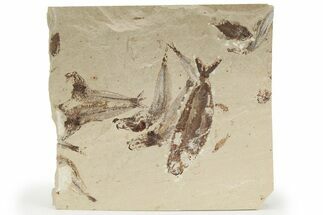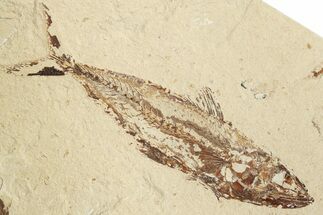This Specimen has been sold.
3 Cretaceous Fossil Fish (Ctenothrissa & Nematonotus) - Lebanon
This is a trio of Cretaceous aged fossil fish from the famous deposits near Hakel, Lebanon. There is a 2.1" long Ctenothrissa and a pair of similarly sized Nematonotus nicely presented on a 7x4" section of limestone. It comes with an acrylic display stand.
The discovery of amazingly preserved marine fossils near Hakel, Lebanon dates back many centuries. In fact they were first mentioned in writing by Herodotus, over 450 years before the birth of Christ. The first scientific work on these localities began in the 1800's and these deposits have been meticulously quarried by several Lebanese families for over a century. We purchase our specimens directly from one of these families that have worked the quarries for generations.
These deposits represent a warm, shallow sea and have yielded over 70 types of fish as well as numerous other genre found no where else in the world. The preservation on many of these specimens is truly amazing including including examples of soft bodied preservation.
The discovery of amazingly preserved marine fossils near Hakel, Lebanon dates back many centuries. In fact they were first mentioned in writing by Herodotus, over 450 years before the birth of Christ. The first scientific work on these localities began in the 1800's and these deposits have been meticulously quarried by several Lebanese families for over a century. We purchase our specimens directly from one of these families that have worked the quarries for generations.
These deposits represent a warm, shallow sea and have yielded over 70 types of fish as well as numerous other genre found no where else in the world. The preservation on many of these specimens is truly amazing including including examples of soft bodied preservation.
SPECIES
Ctenothrissa sp. & Nematonotus
LOCATION
Hakel, Byblos, Lebanon
FORMATION
Sannine Formation
SIZE
Largest fish 2.3" on 7x4" limestone
CATEGORY
SUB CATEGORY
ITEM
#48531
We guarantee the authenticity of all of our specimens.
 Reviews
Reviews















